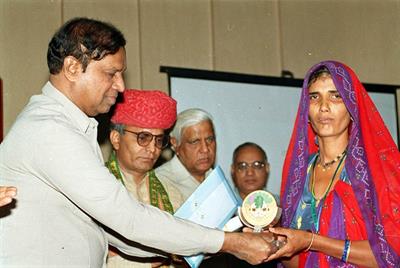PDF chapter test TRY NOW
Managing of forest resources wisely and judiciously to make them available for future generations is referred to as sustainable management of forests.
Sustainable development encourages the judicious use of forest resources to meet current needs while preserving future generations' needs. For a healthy environment, nearly 33\% of the land must be present under forest cover. It is difficult for the forest department to safeguard the forest, its resources, and the wildlife solely through its own efforts.
There have been numerous examples of local people working for forest conservation. For example, in 1971, the Bishnoi community in Rajasthan, for whom conservation of forest and wildlife has been a religious duty, sacrificed 363 lives along with Amrita Devi Bishnoi for the protection of Khejri trees in the Khejrali village near Jodhpur in Rajasthan.
In honour of Amrita Devi Bishnoi, who lost her life along with 363 others, the Indian government has established the "Amrita Devi Bishnoi National Award for Wildlife Conservation" in the memory and exemplary valour of the Bishnoi community. While the government and conservationists play an important role in forest protection and conservation, locals who live in harmony with natural resources are critical to forest conservation efforts.

Amrita Devi Bishnoi National Award for wildlife conservation being presented to a woman for her contribution to the conservation of wildlife
An example is described below. In the Great Himalayan National Park's reserved area, alpine meadows were grazed by sheep in the summer. Every summer, nomadic shepherds drove their flocks up from the valleys. This practice was abolished when the national park was established. It has now been discovered that the grass grows quite tall without regular grazing by sheep and then falls over, preventing new growth.
Through this example, we can see that using force to keep local people out of protected areas cannot possibly be successful in the long run. The destruction of forests cannot be attributed solely to local people and is also caused due to industrial requirements or development projects such as building roads or dams.
We must admit that human intervention has had a significant role in the damage caused to the forest. Forest resources should be managed in an environmentally and developmentallysound manner, that is, while the environment is conserved, the advantages of controlled exploitation should go to the local people, a process in which decentralised economic growth and ecological conservation go hand in hand. The type of economic and social growth we desire will ultimately determine whether the environment is preserved or destroyed further.
The environment should not be viewed as a perfect collection of flora and animals. It is a vast and complicated entity that provides us with various natural resources. We must use extreme caution when utilising these resources for our economic and social development and address our basic needs.
Reference:
https://commons.wikimedia.org/wiki/File:Amrita_Devi_Bishnoi_award.jpg
